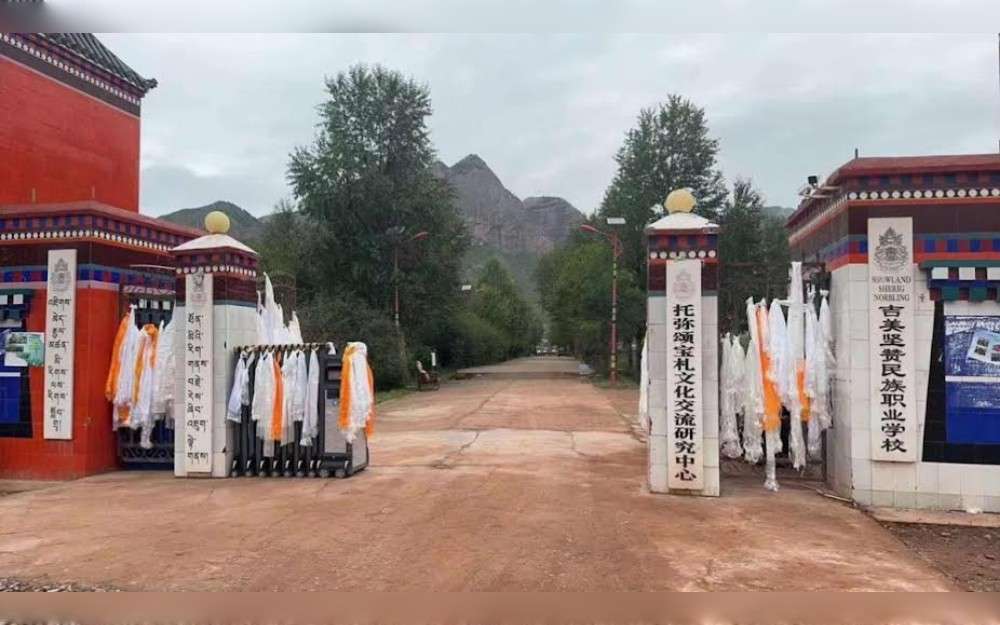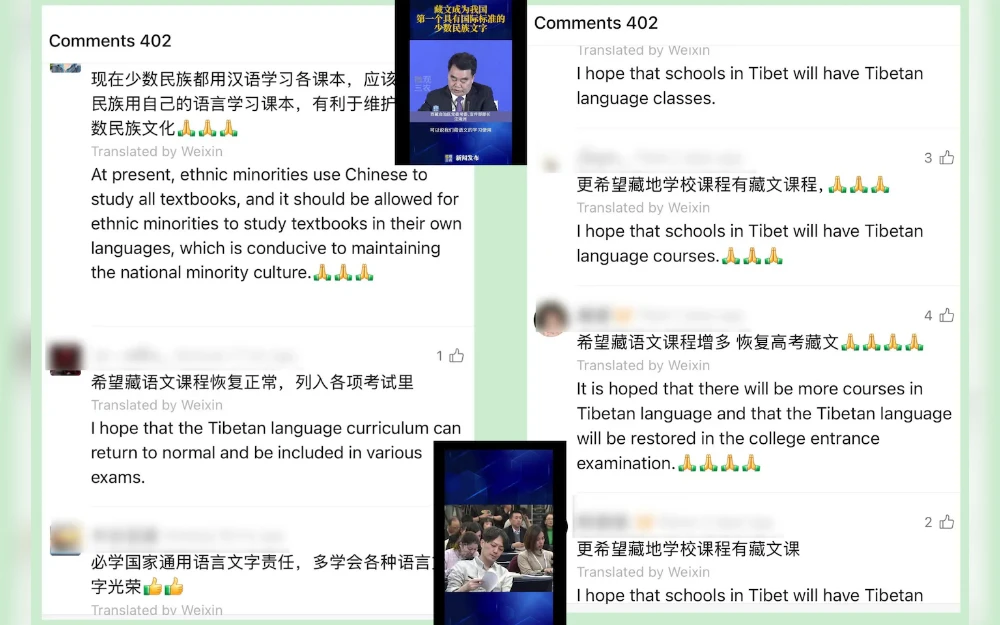Beijing claims Tibetans have right to use their own language but reality shows widespread suppression.
By Tenzin Pema and Dickey Kundol for RFA Tibetan

Hundreds of Tibetans have taken to social media to demand that China restore Tibetan language studies in schools, just days after Beijing released a white paper claiming that the right to use Tibetan language is guaranteed in Tibet.
In the March 28 report about human rights in Tibet, China said the use of Tibetan language is widespread in government documents, public notices, media and schools, and that courses on both Mandarin and Tibetan are taught in primary and secondary schools in the region.
But Tibetans say that isn’t true, and that China has actively moved to suppress use of the language — which they see as part of a wider plan to eliminate Tibetan cultural identity entirely.
In 2020, for example, Mandarin was made the primary medium of instruction in all the primary and secondary schools in Tibet. It was called “bilingual” education but in reality Mandarin was used much more.

In 2023, China started a Mandarin-only policy for students taking the annual college entrance exam, putting many ethnic minorities including Tibetan children -– who were previously allowed to take the test in their native language –- at a disadvantage.
Even the title of the white paper — “Human Rights in Xizang in the New Era” — used the term Beijing-promoted term “Xizang” to refer to Tibet, another clear sign of attempts to assimilate Tibetans under Han Chinese culture.
‘Precious wealth’
In reaction to the white paper, Tibetans left thousands of angry comments underneath several videos posted on the WeChat social media platform showing Chinese officials discussing the contents of the white paper.
“Language and culture are the most precious wealth in the world…Restore Tibetan language in college entrance exams,” a netizen from Tibet posted.
“No matter which nationality, as long as there is a language, it needs to be supported by the government and included in textbooks so that children can learn their mother tongue,” wrote another Tibetan.
“The Tibetan script and language carries a long and rich history and culture of the Tibetan people,” said another post. “However, at present, Tibetan language is not seen in college entrance examinations and many workplaces do not use Tibetan language.”
Outside experts also said that Beijing has actively tried to suppress the use of the Tibetan language.
“The Chinese government has made sure that the Tibetan language remains practically useless in daily life, whether it is for education or to earn a living,” said Dawa Tsering, Director, Tibet Policy Institute, told Radio Free Asia.
Government claims don’t square with reality
The white paper focused on the use of Tibetan in the Tibetan Autonomous Region, or TAR, a Chinese government-designed administrative region that makes up part of the larger region that Tibetans refer to as “Greater Tibet,“ which includes chunks of Sichuan, Gansu, Qinghai and Yunnan provinces.
It claimed that there are 17 periodicals and 11 newspapers available in Tibetan language, and that government published 46.85 million copies of 8,794 Tibetan language books by the end of 2024.

“The right to study and use the Tibetan language in public administration is guaranteed,” Karma Tsetan, chairman of the TAR government, said during the March 28 press conference.
“The right to study and develop the Tibetan language is also guaranteed in education and in the standardization of important terms. Courses on both standard Chinese and Tibetan are taught in primary and secondary schools,” he said.
But that doesn’t square with the reality on the ground.
In July 2024, Chinese officials announced the closure of Gangjong Sherig Norling School, known for its education on Tibetan culture, philosophy and religion, in Golog county in the historic Amdo region of Tibet.
That same month, monastic schools of Kirti Monastery in Ngaba county and Lhamo Kirti Monastery in Dzoge county were closed and a total of 1,600 young monks were forced to enroll in state-run residential schools that analysts say are aimed at making young Tibetans more loyal to the Chinese Communist Party than to Buddhism.
And across Tibetan regions, children as young as 6 are required to enrol in boarding schools which now have military veterans posted as “solder instructors” to instill loyalty to the party.
Restricted access
China has severely restricted outsiders from entering Tibet, making it extremely difficult to describe the situation on the ground.
But outside experts who have managed to visit Tibet say that Mandarin has become the dominant language.
In December 2024, three members of the New Delhi-based think tank India Foundation, who went on a supervised visit to Tibet’s capital Lhasa, told Radio Free Asia that Tibetan now “plays second fiddle” to Mandarin and is treated as second language, with all main signages in Mandarin.
China’s claims about human rights in Tibet does not reflect the reality on the ground, and urged Beijing to enable unfettered access for outside observers, independent researchers, said Maya Wang, associate China director at Human Rights Watch.
“Over the past two decades, the Chinese government has implemented increasingly tightened control over Tibetans, as part of its wider efforts to forcibly assimilate minorities,” she said.
“This high level of repression long documented by human rights organizations and media organizations in exile is in sharp contrast to the Chinese government’s claims about protecting human rights in Tibet.”

The United States has pressed China to open up access to Tibet.
On March 31, U.S. Secretary of State Marco Rubio said Washington was imposing visa restrictions against Chinese officials engaged in efforts to restrict American diplomats, journalists, and other international observers access to Tibet, even as China’s diplomats and journalists enjoy broad access in the United States.
“I urge the Chinese Communist Party to immediately address the lack of reciprocity and allow diplomats, among others, unrestricted access to the TAR and other Tibetan areas,” Rubio said.
A State Department spokesperson told RFA it cannot name the Chinese officials affected by the visa restrictions as U.S. law requires individual visa records to be kept confidential.
“We continue to call on the Chinese government to protect the human rights of Tibetans, preserve their unique identity, and resume dialogue with His Holiness the Dalai Lama or his representatives, without preconditions, to work toward a negotiated solution and meaningful autonomy for Tibetans,” the State Department spokesperson told Radio Free Asia.
Tenzin Lekshay, spokesperson of the Central Tibetan Administration — the Tibetan government-in-exile — in Dharamsala, India, welcomed the U.S. move, calling it “timely” as it comes just days after the Chinese government claimed it has made “all-round and historic progress” in ensuring human rights inside Tibet.
“The Chinese government claimed that Tibetans in Tibet enjoy complete freedom, but unrestricted access for impartial international observers into Tibet will prove that’s not the case,” Lekshay told Radio Free Asia.
Additional reporting by Tenzin Norzom and Dorjee Dolma. Edited by Malcolm Foster.
“Copyright © 1998-2023, RFA.
Used with the permission of Radio Free Asia,
2025 M St. NW, Suite 300, Washington, D.C. 20036.
https://www.rfa.org.”













